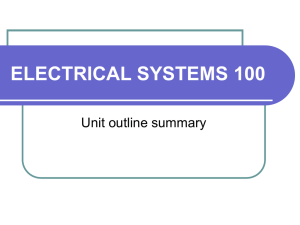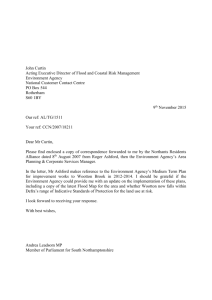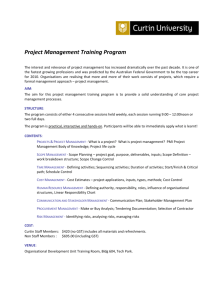The Strategic Development of Quality Teaching
advertisement
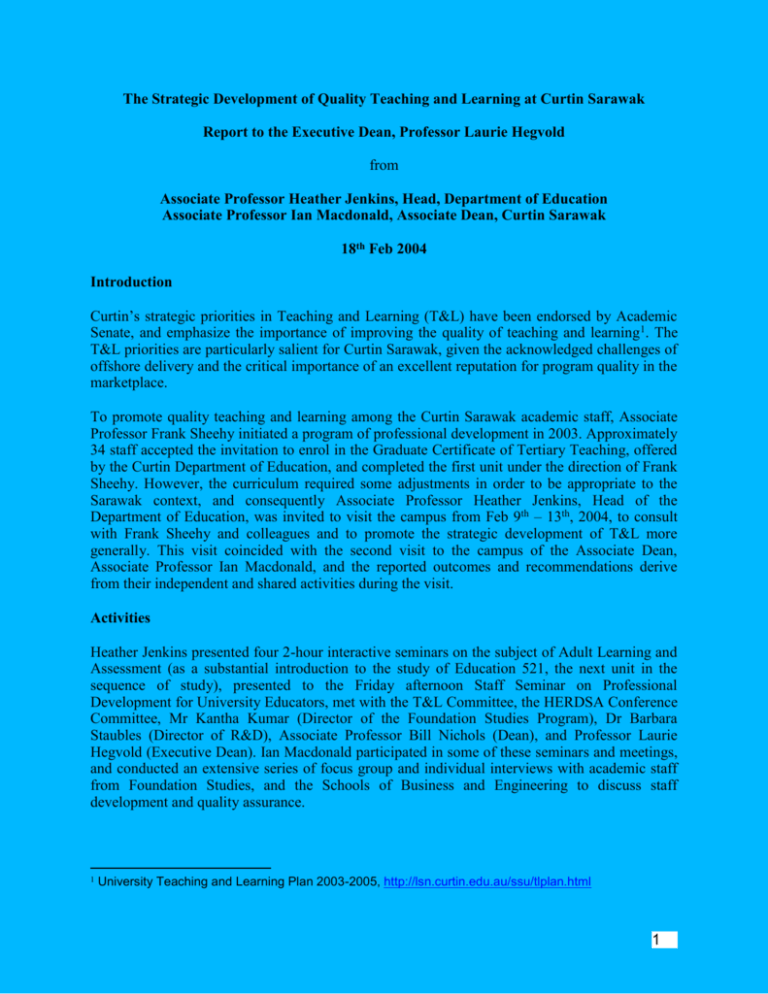
The Strategic Development of Quality Teaching and Learning at Curtin Sarawak Report to the Executive Dean, Professor Laurie Hegvold from Associate Professor Heather Jenkins, Head, Department of Education Associate Professor Ian Macdonald, Associate Dean, Curtin Sarawak 18th Feb 2004 Introduction Curtin’s strategic priorities in Teaching and Learning (T&L) have been endorsed by Academic Senate, and emphasize the importance of improving the quality of teaching and learning1. The T&L priorities are particularly salient for Curtin Sarawak, given the acknowledged challenges of offshore delivery and the critical importance of an excellent reputation for program quality in the marketplace. To promote quality teaching and learning among the Curtin Sarawak academic staff, Associate Professor Frank Sheehy initiated a program of professional development in 2003. Approximately 34 staff accepted the invitation to enrol in the Graduate Certificate of Tertiary Teaching, offered by the Curtin Department of Education, and completed the first unit under the direction of Frank Sheehy. However, the curriculum required some adjustments in order to be appropriate to the Sarawak context, and consequently Associate Professor Heather Jenkins, Head of the Department of Education, was invited to visit the campus from Feb 9th – 13th, 2004, to consult with Frank Sheehy and colleagues and to promote the strategic development of T&L more generally. This visit coincided with the second visit to the campus of the Associate Dean, Associate Professor Ian Macdonald, and the reported outcomes and recommendations derive from their independent and shared activities during the visit. Activities Heather Jenkins presented four 2-hour interactive seminars on the subject of Adult Learning and Assessment (as a substantial introduction to the study of Education 521, the next unit in the sequence of study), presented to the Friday afternoon Staff Seminar on Professional Development for University Educators, met with the T&L Committee, the HERDSA Conference Committee, Mr Kantha Kumar (Director of the Foundation Studies Program), Dr Barbara Staubles (Director of R&D), Associate Professor Bill Nichols (Dean), and Professor Laurie Hegvold (Executive Dean). Ian Macdonald participated in some of these seminars and meetings, and conducted an extensive series of focus group and individual interviews with academic staff from Foundation Studies, and the Schools of Business and Engineering to discuss staff development and quality assurance. 1 University Teaching and Learning Plan 2003-2005, http://lsn.curtin.edu.au/ssu/tlplan.html 1 Outcomes and Recommendations Academic staff participation in the seminars was excellent, with 25-30 in attendance each day, and considerable discussion regarding the application of the T&L unit materials and the issues generated in the local context. The meetings and interviews were similarly characterized by goodwill and an open discussion of the rewards and challenges associated with the delivery of an effective program and academic development more generally. The strengths of the current situation emerged as follows: Academic staff participating in the Graduate Certificate are benefiting from their learning and discussion, and reflecting on their teaching and learning practices The diversity of staff qualifications and background is much broader than expected, and provides a significant experiential base for the group to draw upon. English communication skills in open forum are very good. The regular meetings led by Frank Sheehy are promoting a community of learners, which is acknowledged in the literature as essential for professional development among teachers Staff commented on the strong sense of community among the academic staff, linking across schools and programs. Staff are very committed to the development of their academic careers Remarkable progress has been made in extending research participation and publications output ( including T&L research), with most academic staff active in a research group. The participation of some staff in the WA Universities’ Teaching and Learning Forum at Murdoch University is a very positive sign of their professional activity in the T&L area The HERDSA Conference to be held on the campus in July 2004 will provide a significant impetus and important role modelling for the value of T&L in University contexts internationally. The Committee has secured very prominent keynote speakers and significant sponsorship, and this event will highlight the value of T&L very effectively. Problems that emerged consistently from discussions and interviews included the following: The majority of academic staff are inexperienced and have little knowledge of the role of an academic in an Australian university. There are few senior or long-term staff who are familiar with the Australian university context and therefore opportunities for mentoring and guidance are limited. 2 Some staff felt disempowered by their inability to participate in the construction or evaluation of assessment tasks associated with teaching units. Given that assessment drives the student learning, they sought to have a more effective partnership with the Unit Coordinators in Perth, but were uncertain how to achieve this. Some staff were frustrated by changes in unit content at short notice. Staff capacity to insist on policy implementation (e.g. that unit outlines must not be changed after their distribution) is restricted by their lack of familiarity with unit coordinators and with Curtin policies in general. There is evidently considerable variation in the quality of materials supplied for the delivery of lectures, and some appropriate standardized expectations need to be developed in consultation with lecturers in Perth. Support materials and recommended references need to be provided in a more timely manner. The majority of students had experienced a secondary education based on passive learning and rote memorization, and shifting this culture towards more active student participation in learning was a major challenge. The support provided by a program of professional development in T&L, plus the associated collegial support, was helping to address this issue. The absence of Student Support Services has meant that academic staff were sometimes asked to provide counselling and remedial study skills that were outside their level of professional expertise. Similarly, the Foundation English teaching staff reported that some students in the degree programs sought further language support from them. There was uncertainty regarding the role of quality T&L in promotion procedures. Most staff wanted to advance their research careers and perceived that T&L was not a priority in gaining promotion. The organizational structures also appeared to favour R&D over T&L as the major priority for staff on the campus. This contrasted with the acknowledged significance of the T&L programs in ensuring the financial viability of the campus. The academic staff were uncertain regarding their standing and identity within Curtin University as a whole, and sought greater interaction with staff and affirmation of their achievements (e.g. inclusion of their publications in the Curtin Publications compendium). Recommendations The strategic development of quality teaching and learning must be sustainable over the longer term at Curtin Sarawak, and the following recommendations are addressed towards this goal. 1. Organizational Development: It is recommended that 3 a. A position of teaching leadership is established, to provide expertise and modelling of excellent T&L practices. The position title should be Director of T&L, parallel to the current role of Director of R&D. The proposed position should be 0.5 FTE, and duties would include chairing the T&L Committee, reporting to Academic Board, leading and guiding the academic staff in professional development activities related to T&L, implementing staff and student evaluation of teaching and learning, facilitating the liaison between Sarawak and Perth-based staff, and providing other forms of learning support as required. b. The articulation of career paths for academics at Curtin Sarawak is formalized with acknowledgment of the special circumstances associated with offshore delivery, and clear priority given to expertise in T&L as a pre-requisite for advancement. 2. Resource Allocation: It is recommended that a. The proposed 0.5 FTE role of Director of T&L is resourced equitably with the role of Director of R&D b. Curtin Sarawak continues to support the participation of academic staff in postgraduate programs (such as the Graduate Certificate in Tertiary Teaching) that contribute to the improvement of teaching and learning quality c. The staff seminar program of R&D and T&L innovations is sustained by ensuring that the Friday afternoon timeslot is maintained as a common non-teaching time across the campus 3. Academic Workforce Development: It is recommended that a. A program of staff education about Curtin policies and systems is implemented, that communicates the Bentley/Miri service agreement and clearly specifies the respective rights and responsibilities b. Staff are encouraged to participate in reviews of student performance and to form collegial or study groups that promote the collaborative development of improved teaching and learning c. Staff select professional development opportunities in teaching and learning that lead to formal accreditation d. Staff are assisted by management to establish more equitable working relationships with unit coordinators based in Perth, and establish mentoring relationships with more experienced academics 4 e. The proposed Director of T&L develops, in consultation with staff, a Student Evaluation of Teaching instrument that is both culturally and locally appropriate for implementation on the Curtin Sarawak campus. f. Annual reviews for staff with their line managers incorporate an explicit item on teaching and learning quality, and encourage the development of career portfolios. g. A Curtin Sarawak system of teaching awards is implemented, to provide incentives and showcase excellent teaching practices. Conclusion The opportunity to visit the Curtin Sarawak campus and focus on the strategic development of T&L was informative and the willingness of staff to engage in extensive discussion was most appreciated. With appropriate support, Curtin Sarawak has the potential to achieve a distinctive model for off-shore delivery, informed by tertiary teaching and learning research, and leading to the development of culturally appropriate curriculum practices enabling students to graduate as self-reflective lifelong learners. 5
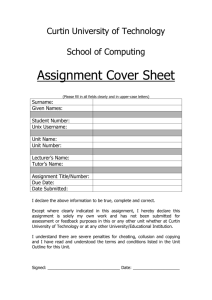

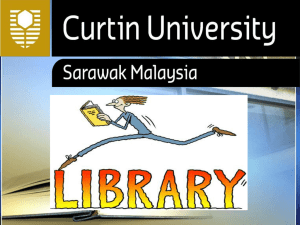
![Assignment coversheet (single) [ 48KB]](http://s3.studylib.net/store/data/008375796_1-47bef2c2c4eb4b7696d1fc3a80518558-300x300.png)
![Assignment coversheet (group) [ 126KB]](http://s3.studylib.net/store/data/008375797_1-0b6687da490940610c4ecb23456dda46-300x300.png)
